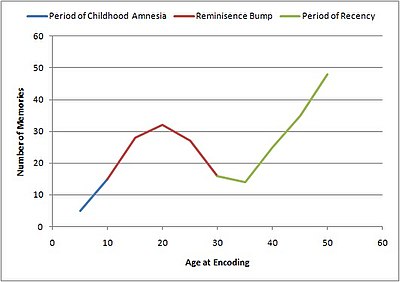
The reminiscence bump is the tendency for older adults (over forty) to have increased or enhanced recollection for events that occurred during their adolescence and early adulthood.[1] It was identified through the study of autobiographical memory and the subsequent plotting of the age of encoding of memories to form the lifespan retrieval curve.
The lifespan retrieval curve is a graph that represents the number of autobiographical memories encoded at various ages during the life span. The lifespan retrieval curve contains three different parts.[2] From birth to five years old is a period of childhood amnesia, from 15 to 25 years old is the reminiscence bump and last is a period of forgetting from the end of the reminiscence bump to present time.[2] The reminiscence bump has been observed on the lifespan retrieval curve in multiple studies.
Theorists have proposed several explanations, ranging from changes in brain biology to the type of events that typically occur during this time period. Researchers have consistently observed the reminiscence bump, the period of increased memory accessibility in participants' lifespan retrieval curves, and the bump has been reproduced under a range of study conditions.
- ^ Jansari, A.; Parkin, A. J. (1996). "Things that go bump in your life: Explaining the reminiscence bump in autobiographical memory". Psychology and Aging. 11 (1): 85–91. doi:10.1037/0882-7974.11.1.85. PMID 8726374.
- ^ a b Conway, Martin A.; Haque, Shamsul (January 1999). "Overshadowing the reminiscence bump: Memories of a struggle for independence". Journal of Adult Development. 6 (1): 35–44. doi:10.1023/A:1021672208155. ISSN 1068-0667. S2CID 140993936.
© MMXXIII Rich X Search. We shall prevail. All rights reserved. Rich X Search
